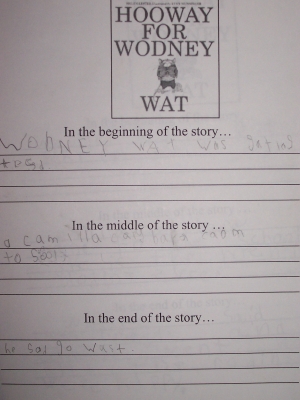TEACHER: Sarah DesLauriers
CLASS: Ms. D’s 1st/2nd grade.
DATE: April 11, 2003
CONTEXT: Language Arts
TOPIC: Wodney Wat Writing.
TIME: 30 minutes
OBJECTIVES:
Students will make predictions during the reading of
the story.
Students will write three sentences about what happened
in the story. (Beginning, Middle, End)
RELATED STANDARDS:
VT Standards 1.13: Students listen actively and respond
to communications. This is evident when students ask clarifying questions,
restate and respond through discussion, writing, and using art forms.
MATERIALS:
Hooway for Wodney Wat by Helen Lester
Worksheet
Pencils
TEACHING-LEARNING PROCEDURE:
• Teacher will have students come to the front of the
room and sit in storytime.
• Teacher will tell students what they are supposed to
do, “I’m going to read you …Wodney Wat, I want you to listen closely to
what happens in the beginning, middle, and end of the story. I’m
going to ask you to write something about them after the story.”
• Teacher will picture walk the book.
• Teacher will read the book to the students.
• On page 9, teacher will ask the students what they
think the rest of the story is going to be about.
• On page 16 teacher will ask, “Who do you think it will
be?”
• On page 19 teacher will ask, What is going to happen
next?”
• After the story, teacher will ask what the students
thought of the story.
• Teacher will ask the students what happened in the
beginning, the middle and the end.
• Next the teacher will pull out the worksheet and explain
to children what they need to do. (write a sentence about the beginning,
middle, and end so that someone reading their paper will be able to understand
what the story is about)
• Teacher will give students the worksheet and have then
go to their seats to work on them.
• Teacher will walk around and help students who need
help.
STUDENT ASSESSMENT:
I can assess students by looking at their writing and
listening to their thoughts and their predictions during the story.
TEACHER ASSESSMENT:
I will know if I have been successful if the children
write the beginning, middle and end of the story and if they seem engaged
during the story.
|
This lesson was created so that the students could practice the literary
elements of beginning, middle, and end. Many students needed more
practice in this particular area. |
| This is an image of Stan's work. In the story Rodney Rat (often
spelled Wodney Wat) is teased by his classmates and they pick on him about
his speech problem, however, when Camilla Cabybara comes to school and
gives everyone a taste of their medicine, they see what they did wrong.
Wodney gets Camilla to leave during a game of Simon Says when he tells
the group to go rest, and she ends up going west. Stan was able to
remember small details, however, when you read the paper you are unable
to get a clear idea what the story was about as you are told that Wodney
gets teased, Camilla come to school, and the "he" says go west. Stan
needs more practice in getting a point across in writing. I spoke
to him and asked him what else he remember, but he was unable to give me
more information. Later, I differentiated instruction (PC 2b)
by taking him aside later that day and rereading the book with him.
I had him retell me the story using words, this was much more successful
for him. |

|